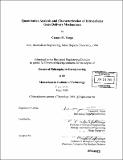Quantitative analysis and characterization of intracellular gene delivery mechanisms
Author(s)
Varga, Csanad M. (Csanad Mathias), 1976-
DownloadFull printable version (5.318Mb)
Alternative title
Quantitative analysis and characterization of cellular gene delivery mechanics
Other Contributors
Massachusetts Institute of Technology. Biological Engineering Division.
Advisor
Douglas A. Lauffenburger.
Terms of use
Metadata
Show full item recordAbstract
A goal for gene delivery research is to design vectors capable of (a) delivering transgenes to target cells, (b) yielding efficient gene expression, and (c) minimizing any immune, inflammatory, or cytotoxic response. Current research has focused on developing such vehicles using end gene expression as the benchmark. While transgene protein production is the overall objective of successful gene delivery, such qualitative treatment of gene delivery, especially for non-viral vectors, may result in unoptimized vectors and potential rate limiting steps unidentified. Quantitative analysis of the gene delivery pathway is essential for the characterization, comparison, and design of vectors. The complex nature of the mechanisms for gene delivery, particularly at the cellular level, contains multiple potentially rate limiting steps to successful gene expression. Through quantitative methodologies, vector efficacy can be related to molecular characteristics and specific processes within the gene delivery pathway. These potentially rate limiting steps include, but are not limited to, cell surface association, subcellular trafficking, endosomal escape, nuclear translocation, vector unpackaging, and gene expression. Design of synthetic gene delivery vectors seeks to develop molecular systems mimicking virus-like infection behavior, including cell membrane attachment and rapid internalization followed by endosomal escape, nuclear localization, and finally gene expression. To explore such opportunities for vector optimization and design, a model human hepatocellular carcinoma cell line by sets of transfection agents complexed with a plasmid. Time courses of plasmid numbers were determined both from whole cells and from isolated nuclei by real-time quantitative PCR. (cont.) This enabled determination of values for parameters characterizing the key intracellular trafficking processes for a validated mass-action kinetic model of cellular gene delivery, in concert with model parameter values obtained from literature data. Quantitative parameter sensitivity analyses were performed for the individual gene delivery vectors, permitting elucidation of the particular rate-limiting processes specific to each vector. The resulting model predictions were then extended to test effect of increased delivery by polyethylenimine based gene delivery vectors and thus model utility. Additionally, viral vector performance was measured, providing insight into the extreme efficiency of such vectors. As no single process was found to be rate-limiting for all vectors, nor was the rate-limiting process necessarily the kinetically-slowest process. Thus, a single design factor will not likely improve all types of vectors, but rather each vector must be improved with respect to its own specific rate-limiting process(es) and improvements in vehicle design may best arise from quantitative analysis of the contributions of each to the integrated system operation.
Description
Thesis (Ph. D. in Bioengineering)--Massachusetts Institute of Technology, Biological Engineering Division, 2003. Leaf 117 blank. Includes bibliographical references.
Date issued
2003Department
Massachusetts Institute of Technology. Department of Biological EngineeringPublisher
Massachusetts Institute of Technology
Keywords
Biological Engineering Division.